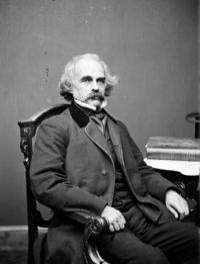LITR 5535: American
Romanticism

Student Presentation on Reading Selections 2006
Monday 9 October: Nathaniel Hawthorne, N 579-584, 610-635 (“Young Goodman Brown,” “May-Pole of Merry Mount,” & “Minister’s Black Veil”)
selection reader / discussion leader: Angela Douglas

Nathaniel
Hawthorne
-
He was born in Salem,
Massachusetts, where his birthplace
is now a house museum.
-
His grandfather, John Hathorne, was one of the judges in the Salem
witchcraft trials of 1692.
- His
best-known works include THE SCARLET LETTER (1850) and THE
HOUSE OF THE SEVEN GABLES (1851).
- His
second, expanded edition of TWICE-TOLD TALES (1837), was praised by
Edgar Allan Poe in Graham's Magazine. "We know of few
compositions which the
critic can more honestly commend that these Twice-Told Tales," Poe
stated. "As Americans, we feel proud of
the book." Poe's
Review
“The Minister’s Black Veil”
“The Minister's Black
Veil” first appeared in an annual anthology, The Token, in 1836, and
was collected in Twice Told Tales the following year. As Hawthorne points
out in a footnote to the story, the character of Mr. Hooper has similarities to
those of a real-life clergyman who died some eighty years earlier, Joseph Moody
of Maine. However, he says, the veil worn by Moody had a different import as
that of Mr. Hooper: the former had accidentally killed a friend, and for the
rest of his life hid his face from men.
The Byronic Hero
ź
The Byronic hero does not possess
"heroic virtue" in the usual sense; instead, he has many dark
qualities.
[Our course objective 1(a)
“Romantic Spirit” says “A Romantic hero or heroine may appear empty or
innocent of anything except readiness or desire to transform or
self-invent.”]
ź
He is usually isolated from society
as a wanderer or is in exile of some kind.
ź
Often the Byronic hero is moody by
nature or passionate about a particular issue.
ź
Due to these characteristics, the
Byronic hero is often a figure of repulsion, as well as fascination.
“The cause of so much
amazement may appear sufficiently slight. Mr. Hooper, a gentlemanly person, of
about thirty, though still a bachelor, was dressed with due clerical neatness,
as if a careful wife had starched his band, and brushed the weekly dust from his
Sunday's garb. There was but one thing remarkable in his appearance. Swathed
about his forehead, and hanging down over his face, so low as to be shaken by
his breath, Mr. Hooper had on a black veil. On a nearer view it seemed to
consist of two folds of crape, which entirely concealed his features, except the
mouth and chin, but probably did not intercept his sight, further than to give a
darkened aspect to all living and inanimate things. With this gloomy shade
before him, good Mr. Hooper walked onward, at a slow and quiet pace, stooping
somewhat, and looking on the ground, as is customary with abstracted men, yet
nodding kindly to those of his parishioners who still waited on the
meeting-house steps. But so wonder-struck were they that his greeting hardly met
with a return.”
“He could not walk the
street with any peace of mind, so conscious was he that the gentle and timid
would turn aside to avoid him, and that others would make it a point of
hardihood to throw themselves in his way.”
Questions:
Does Mr. Hooper fit the
description of a Byronic Hero? If
so, how?
What are Mr. Hooper’s
reasons for wearing the veil?
What are some elements of
the gothic in “The Minister’s Black Veil?”
How does Hawthorne’s
version of the gothic compare to Poe’s?
Poe’s comments on
“The Minister’s Black Veil”
“The Minister's Black
Veil” is a masterly composition of in which the sole defect is that to the
rabble its exquisite skill will be caviare. The obvious meaning of
this article will be found to smother its insinuated one. The moral put
into the mouth of the dying minister will be supposed to convey the true import
of the narrative; and that a crime of dark dye, (having reference to the
"young lady") has been committed, is a point which only minds
congenial with that of the author will perceive.”
|
|
|
|

